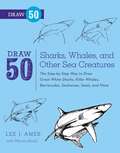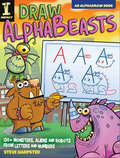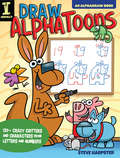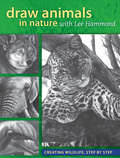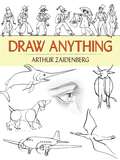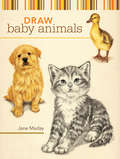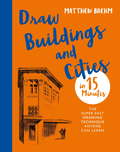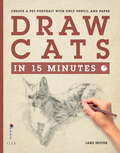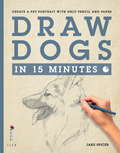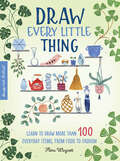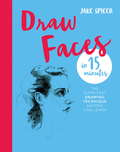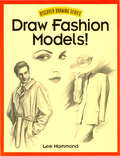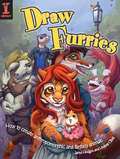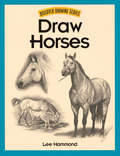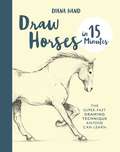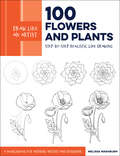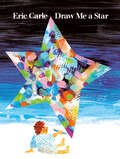- Table View
- List View
Draw 50 Sharks, Whales, and Other Sea Creatures: The Step-by-Step Way to Draw Great White Sharks, Killer Whales, Barracudas, Seahorses, Seals, and More... (Draw 50)
by Lee J. Ames Warren BuddLee Ames, together with Warren Budd, present 50 inhabitants of the deep in step-by-step sketches. "Includes no less than 11 kinds of sharks and 13 animals of the whale family." -- School Library Journal.From the Trade Paperback edition.
Draw 50 Vehicles: The Step-by-Step Way to Draw Speedboats, Spaceships, Fire Trucks, and Many More... (Draw 50)
by Lee J. AmesIncludes sections from two of the most popular Lee Ames titles: Draw 50 Boats, Ships, Trucks & Trains and Draw 50 Airplanes.From the Trade Paperback edition.
Draw ANYTHING with Felt-Tip Pens & Markers
by Holly WalesDiscover your drawing and creative skills with this fun-packed book, designed to take your pack of pens further.There is more fun to be had with felt-tips than colouring. With her trademark vibrant and energetic style, felt-tip illustrator Holly Wales shakes up your humble pack of pens and gives you the best tips on the tips.Learn how to draw, decorate, doodle and embellish using every colour and permutation of the pen. More fun, more inky and more vibrant than pencils and pastels, Draw ANYTHING with Felt-Tip Pens & Markers is the perfect way to discover your creative talents.
Draw Along Animals: Sketch Your Way Through the Animal Kingdom
by Pippa PixleyLearn how to draw all of your favorite animals with help from artist, Pippa PixleyJoin author and artist, Pippa Pixley, as she teaches you how to draw animals of all shapes and sizes. All animals are shown in a simple step-by-step format so budding artists can follow along with ease, while adding their own artistic flair and personal touches.This book will inspire creativity and resourcefulness with pages on how to make and use your very own inks. Learn about techniques such as mark-making, mixing colors, and shading to create texture and add depth to drawings. Go wild and experiment with different materials like charcoal and graphite, and let your imagination run free across the page.This learn-to-draw book features:A collection of cute animals to draw in all different shapes and sizes.Simple draw-along steps that are straightforward and sketchy, making it easy for children to follow along.Tips on how to use different natural materials and techniques to improve their skills.With Pippa Pixley’s Draw Along, little ones will be creating masterpieces in no time! From cheeky chickens to sleepy sloths, and brilliant bugs to little lambs, whatever your favorite animal is, Pippa can teach you how to draw it! Perfect for young artists of all ages, whether learning to draw for the first time or refining more advanced skills, this book has something for everyone. Inspire imagination and spark a journey of creativity and artistry that will last for years to come.
Draw AlphaBeasts: 130+ Monsters, Aliens and Robots From Letters and Numbers (AlphaDraw)
by Steve HarpsterLearn to draw more 130 imaginary creatures using letters and numbers as the starting point! From kooky monsters to silly ghouls and goofy aliens, you can draw any kind of crazy creature in just a few simple steps. Practicing your letters and numbers is fun when you can turn them into characters from your imagination!Easy-to-follow guided drawings130+ charactersReinforce alphabet and counting skills
Draw AlphaToons: 130+ Crazy Critters and Characters From Letters and Numbers (AlphaDraw)
by Steve HarpsterLions and tigers and bears, oh my! Drawing AlphaToons is as easy as 1, 2, 3...or A, B, C! Turn letters and numbers into animals, pets and crazy characters. Step-by-step pictures show you how to draw everything from pigs, sloths and piranhas to cuddly kittens and zany cartoon people using different letters and numbers as a starting point.Learn how to draw more than 130 funny alphabet and number-based cartoonsMake your 'toons wacky by adding mustaches, mohawks and even word balloonsPerfect for beginner artistsWhen N becomes a nervous rhino, G becomes a goofy granny and the number 8 becomes a purple panda, the fun really begins.
Draw Animals in Nature With Lee Hammond: Creating Wildlife, Step by Step
by Lee HammondPut the WILD in your wildlife art! Popular artist and best-selling author Lee Hammond shares her secrets for drawing some of the earth's most magnificent animals and the diverse habitats they call home. This guide breaks the challenge down step by step, showing beginners how to instantly improve accuracy in their work and inpiring more experienced artists to achieve the level of heart-beating realism illustrated inside. 30 start-to-finish demonstrations feature a wide variety of wild animals and birds, from large cats and raptors to small woodland creatures and reptiles Mini-lessons focus on drawing eyes, fur, feathers, antlers and other lifelike textures Includes expert tips for evoking the atmosphere of meadows, woodlands, mountains, skies and other natural terrains Builds on key skills--including Hammond's blended pencil technique--that make the difference between a simple line drawing and stunning realism With Hammond's proven techniques and friendly teaching style, you'll soon be able to draw not just the wonderful variety of scenes in this book, but any wildlife moment that touches your heart.
Draw Anything
by Arthur ZaidenbergWritten by an expert art teacher, this visual drawing dictionary offers thousands of instructive illustrations in alphabetical order -- from abdomen to zodiac. Simplified for beginners and intermediate students, it presents a tremendous wealth of images: animals, people performing a variety of activities, and common and uncommon objects, including fruits and flowers, clothing, furniture, and much more.The twofold purpose of this manual is to demonstrate how to construct figures and objects using the "scaffold" forms depicted here, and to serve as a source of information and research. Many of the sketches show basic structures in their simplest elements. In other cases, a relatively complete drawing serves as a base for the display of a costume or demonstration of an activity. A guide to simplification and an essential reference, this book represents a vital resource for artists of all levels, amateur and professional.
Draw Baby Animals
by Jane MadayCapture Every Cute and Cuddly Detail, Step-by-Step!Who can resist the appeal of adorable baby animals? From their big, round eyes to their soft, cuddly fur, these little creatures are a special delight.Now you can learn to draw all your favorites following the step-by-step instruction in this unique guide. It's fun and easy, even if you're new to drawing. Just start at the beginning to discover all the tips and tricks for drawing eyes, ears, muzzles, paws and feet. Once you've got the basics down, you can move on to creating realistic drawings of all kinds of sweet baby animals, including puppies, kittens, bunnies, lambs, foals, penguins, ducklings, fawns, piglets and more.In every complete demonstration, you'll find extra instruction for rendering the unique texture of baby fur and feathers. There's also an in-depth chapter that shows you how to use drawing pencils, select reference photos, create compositions and establish proportions.With Draw Baby Animals, you have everything you need. Give it a try, and see what you can create!
Draw Buildings and Cities in 15 Minutes: Amaze Your Friends With Your Drawing Skills (Draw In 15 Minutes Ser.)
by Matthew BrehmThis book is ideal for anyone with an interest in the visual character of the cities and buildings that frame our lives. Expert art tutor and writer Matthew Brehm helps you capture the life of the places where you work and spend your free time, and the places you visit in your travels. The skills and strategies presented here will help you make a visual record of the urban places you experience, and help you learn about these places in the process. Draw Buildings and Cities in 15 Minutes is a perfect addition to the successful Draw in 15 Minutes series. Responding to the popularity of the Urban Sketchers movement, expert artist Matthew Brehm teaches the reader how to capture the city environment speedily and successfully, while also teaching them essential drawing skills along the way.
Draw Buildings and Cities in 15 Minutes: The super-fast drawing technique anyone can learn (Draw in 15 Minutes #4)
by Matthew BrehmThis book is ideal for anyone with an interest in the visual character of the cities and buildings that frame our lives. Expert art tutor and writer Matthew Brehm helps you capture the life of the places where you work and spend your free time, and the places you visit in your travels. The skills and strategies presented here will help you make a visual record of the urban places you experience, and help you learn about these places in the process. Draw Buildings and Cities in 15 Minutes is a perfect addition to the successful Draw in 15 Minutes series. Responding to the popularity of the Urban Sketchers movement, expert artist Matthew Brehm teaches the reader how to capture the city environment speedily and successfully, while also teaching them essential drawing skills along the way.
Draw Cats in 15 Minutes: Create A Pet Portrait With Only Pencil And Paper (Draw In 15 Minutes Ser.)
by Jake SpicerWith their luxurious fur and distinctive markings, you might think that drawing cats is an impossible challenge. Not so! Professional art tutor Jake Spicer’s unique guide will have you sketching your favourite feline in next to no time.<P><P> Easy-to-follow tutorials take you from learning the basic techniques every artist needs to know to capturing the unique qualities that characterise your cat—including anatomy, details and expression. With its friendly approach and beautifully illustrated lessons, this book ensures that anyone who’s ever wanted to draw a cat will soon be able to.
Draw Cats in 15 Minutes: Create a pet portrait with only pencil & paper (Draw in 15 Minutes #5)
by Jake SpicerWith their luxurious fur and distinctive markings, you might think that drawing cats is an impossible challenge. Not so! Professional art tutor Jake Spicer's unique guide will have you sketching your favourite feline in next to no time.Easy-to-follow tutorials take you from learning the basic techniques every artist needs to know to capturing the unique qualities that characterise your cat-including anatomy, details and expression. With its friendly approach and beautifully illustrated lessons, this book ensures that anyone who's ever wanted to draw a cat will soon be able to.
Draw Dogs in 15 Minutes: Create A Pet Portrait With Only Pencil And Paper (Draw In 15 Minutes Ser.)
by Jake SpicerWith these tutorials you'll go from sketching the basic outline of your furry friend, through understanding how to approach daunting subjects like fur and anatomy, to adding the details that make each breed and individual dog unique. One step at a time youll see your drawing skills improve, and by the end of the book youll be achieving incredible likenesses in just 15 minutes
Draw Dogs in 15 Minutes: Create a Pet Portrait With Only Pencil and Paper (Draw in 15 Minutes #6)
by Jake SpicerDrawing on his many years of teaching experience, Jake Spicer's Draw in 15 Minutes series is perfect for the complete beginner or amateur draughtsman wanting to take their drawing further. With the thoughtfully constructed and beautifully illustrated tutorials in this book, you'll progress from sketching the basic outline of your furry friend, through understanding how to approach daunting subjects like fur and anatomy, to adding the details that make each breed and individual dog unique. One step at a time you'll see your drawing skills improve, and by the end of the book you'll be achieving incredible likenesses - in just 15 minutes!
Draw Every Little Thing: Learn to Draw More Than 100 Everyday Items, From Food to Fashion (Inspired Artist Ser. #1)
by Flora WaycottLearn to draw and paint more than 100 of your favorite everyday items! Step-by-step projects, prompts, and creative inspiration make it fun and easy to draw your outfit, your favorite foods, your garden, and much more using drawing and painting tools you already have on hand. From learning to draw and paint plants, flowers, and bicycles to the neighborhood café and the contents of the kitchen cabinet, Draw Every Little Thing demonstrates just how easy it is to render the world around you with little more than a pencil, paper, and paint. Following a brief introduction to the joys of simplistic drawing and painting, this aesthetically pleasing book familiarizes you with a range of drawing tools and materials, including graphite pencil, pen and ink, colored pencil, and gouache, before offering a quick overview of basic color theory. Each subsequent chapter is then devoted to a specific theme—kitchenalia, hobbies, neighborhood haunts, and much more—and packed with simple step-by-step drawing projects. This accessible book encourages you to jump around so you can draw what immediately inspires you. Interactive prompts, creative exercises, and inspiring ideas make the process fun and engaging. Easy techniques and helpful instructions show you how to develop your own personal style, as well as add color to your drawings using gouache and colored pencil. Crafty projects round out the book, allowing you to use your newfound drawing and painting skills. Filled to the brim with whimsical artwork and loads of creative ideas, Draw Every Little Thing encourages artists of all skill levels to draw any time inspiration strikes. The Inspired Artist series invites art hobbyists and casual art enthusiasts to have fun learning basic art concepts, relaxing into the creative process to make art in a playful, contemporary style. Expand your creative exploration of the everyday with the fun follow-up book, Inspired Artist: Paint Every Little Thing (September 2021). Also from the series, find even more artistic inspiration with Block Print for Beginners (March 2021) and Watercolor Painting at Home (October 2021).
Draw Faces in 15 Minutes: Amaze Your Friends With Your Portrait Skills (Draw In 15 Minutes Ser.)
by Jake SpicerYes, you can draw! AndDraw Faces in 15 Minutes will show you how to draw people's faces. By the time you finish this book, you'll have all the skills you need to achieve a striking likeness in a drawn portrait, using a proven method from a professional life-drawing teacher. Artist and life-drawing expert Jake Spicer takes you through a series of carefully crafted tutorials, from how to put together a basic portrait sketch to developing your portraits and then taking your drawings further. From understanding and constructing the head and shaping the hair, to checking the relationships of the features and achieving a lifelike expression, every aspect of the portrait process is examined, along with advice on which materials to use and how to find a model. Inside you'll find beautifully illustrated, easy-to-follow, step-by-step chapters that make it easy for anyone to draw a face.
Draw Faces in 15 Minutes: Amaze your friends with your portrait skills (Draw in 15 Minutes #1)
by Jake SpicerYes, you can draw! And Draw Faces in 15 Minutes will show you how. By the time you finish this book, you'll have all the skills you need to achieve a striking likeness in a drawn portrait.Artist and life drawing expert Jake Spicer takes you through a series of carefully crafted tutorials, from how to put together a basic portrait sketch to developing your portraits and then taking your drawings further. From understanding and constructing the head and shaping the hair, to checking the relationships of the features and achieving a lifelike expression, every aspect of the portrait process is examined, along with advice on which materials to use and how to find a model.
Draw Fashion Models! (Discover Drawing)
by Lee HammondIn this step-by-step guide, Lee Hammond reveals secrets that will help you turn your drawings into professional-looking fashion illustrations. You'll start with the basics - like how to draw the human figure as a combination of simple, interlocking shapes and how to use shading to give your work a realistic, three-dimensional quality. Next, you'll learn how to make the fashions look real - with convincing folds, drapes, patters and textures. Exercises and easy-to-follow demonstrations how you how to give your models expressive features, fashionable hair styles and just-the-right accessories. You'll learn how to add impact with cropping and creative backgrounds as you combine pose, expression and lighting to strike a mood and create attitude. If you have a feel for fashion and a creative flair, try your hand at fashion illustrations. This book makes it easy!
Draw Furries: How to Create Anthropomorphic and Fantasy Animals
by Jared Hodges Lindsay CibosHow to Create Anthropomorphic and Fantasy Animal What do you get when you cross a human with a horse (or a hamster, or a hummingbird)? You get any one of a number of fun anthropomorphic animals, also known as "furries" to their friends. From facial expressions to creative coloring, this book contains all the know-how you need to create anthropomorphic cat, dog, horse, rodent and bird characters. Step by step, you'll learn how to:Draw species-appropriate tails, eyes, wings and other fun details Give your characters clothes, poses and personalities Create the perfect backgrounds for your furry antics-with two start-to-finish demonstrations showing how Packed with tons of inspiration-from teeny-bopper bunnies and yorky glamour queens to Ninja squirrels and lion kings-Draw Furries will help you create a world of crazy, cool characters just waiting to burst out of your imagination.
Draw Great Characters and Creatures: 75 Art Exercises For Comics And Animation
by Beverly JohnsonLearn to make your characters unique, compelling and lifelike with these 75 exercises for all skill levels, including beginners. Topics include tools and materials; shapes; personalities; facial expressions; body language; character interaction; and costuming. Character types featured include more than just humans; learn how to draw animals, plants, creatures and more. Author Bev Johnson guides you through a variety of questions to explore not only the kinds of characters you want to create, but also the relationships between them, such as who their friends and enemies are, what their personality distinctions are, etc. so you can you can create truly interesting characters.
Draw Horses (Discover Drawing)
by Lee HammondOffering a realistic approach, clear step-by-step instruction, and an encouraging voice, this book will teach readers how to produce beautiful renderings of one of their favorite animals - horses.
Draw Horses in 15 Minutes: The Super-Fast Drawing Technique Anyone Can Learn (Draw in 15 Minutes #7)
by Diana HandContinuing the success of the Draw in 15 Minutes series, horse artist Diana Hand shows you how to express your love of horses through drawing. In a series of tutorials, she describes every stage from finding your model and learning the basic skills of drawing to portraying the movement and spirit of the individual horse. Draw Horses in 15 Minutes will inspire you to make your own expressive drawings based on the principles of equine anatomy. Furthermore, you will discover a skill you never thought you had.
Draw Like an Artist: 100 Flowers and Plants
by Melissa WashburnAn invaluable visual reference for student artists, botanical illustrators, urban sketchers, and anyone seeking to improve their realistic drawing skills.This comprehensive book features 600-plus step-by-step sketches depicting a vast array of beautiful botanicals, florals, plant structures, and more. Each begins with simple shapes and lines and builds on those forms, adding details like flower centers, leaf veins, and petal shading, and ending with a finished drawing. Helpful drawing tips are also included.Draw Like an Artist: 100 Flowers and Plants shows flower blossoms, leaves, and plants from a variety of perspectives. By following the guides, artists will become more skilled and confident in their ability to draw any flower or greenery. Among the botanicals featured are:Tropical florals such as plumeria, protea, and African violetHanging and vine blooms, including wisteria and morning gloryBirch, white oak, gingko, and maple leavesPlants with interesting shapes, such as cactus, zebra grass, and bamboo
Draw Me a Star
by Eric CarleThis is a story of an artist who, from his earliest years, draws. The artist draws a star! Then, the tree, house, flowers, clouds, rainbow, and night.In drawing, he discovers not only his art, but his life. Holding on to his star, he creates a world of light and possibility.With his brilliant collage, poignant and powerful in its simplicity, Eric Carle creates an unforgettable story that celebrates imagination and the artist in us all.
